

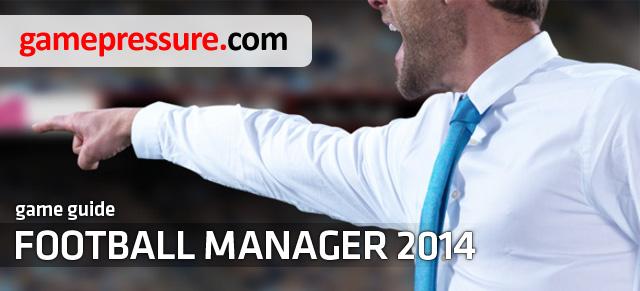
The unofficial guide for Football Manager 2014 is a detailed collection of information on main and minor aspects of the gameplay. It includes general as well as detailed pieces of advice, for beginners and more experienced players. Much attention has been given on advanced strategies, choosing proper training and a detailed description of mechanics of a match. The following chapters also describe transfer negotiations and examples of talents. Finally, the guide includes useful keyboard shortcuts and detailed descriptions of challenges.
Football Manager 2014 strategy guide contains:
Football Manager 2014 is a sport strategy game that lets you try your hand at managing a football team. The game was created by Sports Interactive, the same studio team that's responsible for the previous editions of the series.
The game lets you control every aspect of a football team. You need to organize trainings, transfer players and keep good relations with fans and the press. Choosing teams for specific matches and creating tactical plans are also very important.
The Football Manager 2014 strategy guide was created using version 14.1.3. The settings and initial selection of leagues are shown below.
 All format preferences.
All format preferences.Language
English
Currency
Euro
Wages
Weekly
Temperature
Celsius
Height
Centimeters
Weight
Kilograms
Short distance
Meters
Long distance
Kilometers
Match odds
Decimal (i.e. 16.0)
 Initial leagues.
Initial leagues.Choosing leagues affects which teams will be available, obviously. For example, if you choose Polish Extra League, you can choose teams from I league or only Extra League to be playable. It affects mainly two things: pace of the gameplay (more or less leagues to simulate) and number of players available in the gameplay. The latter is also affected by size of the database.
Moreover, you can also change some advanced options now. When you move the cursor over an option, its description appears. I recommend turning on Show players attributes. It lowers the realism but you'll be able to see all stats of a player, without an in-depth observation.
You can add and remove leagues during the game but changes will appear after the season ends. To do it, choose Add/Remove Leagues.
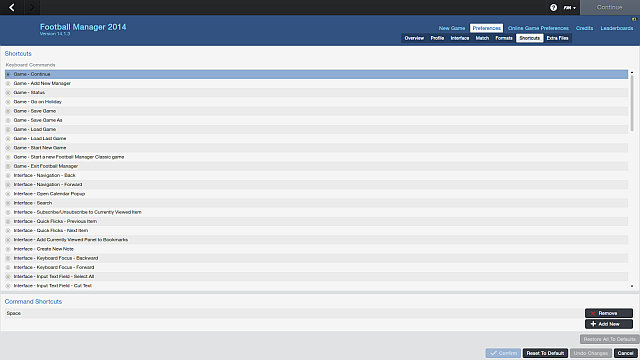 The list of all shortcuts is quite long.
The list of all shortcuts is quite long.The most used and most needed shortcuts are shown below. The full list is at Preferences->Shortcuts.

Continue

Back

Next

Help

Team squad

Inbox

Shortlist

Calendar

Tactics

Training

Transfer centre

League table

Save

Load

Add new manager

Search

Exit

Match speed: fast

Match speed: medium

Match speed: slow

Open calendar

Save a screenshot

Start a new game
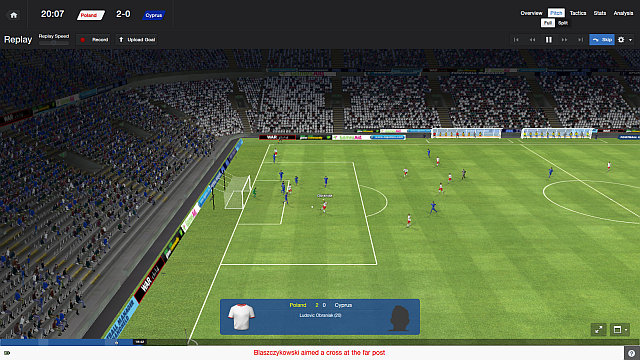 Thanks to this you'll stop England!
Thanks to this you'll stop England!1. Choosing a club
There are no difficulty settings in Football Manager 2014 so you can control it by choosing a right club. For beginners that want to learn the game's mechanics, a strong club from a high league will be a good choice. Million-euro transfers and European cups will be at your fingertips. Then you can choose a weaker team and start its career from the bottom. The rule is simple: the weaker your team is, the harder it is to get somewhere, but the satisfaction of winning the Champions League will be much bigger with a minor team than, for example, Bayern Munich.
2. Choosing a team
Regardless of the club you pick, remember to have a right number of players in your team. Having a substitute goalkeeper and, based on your needs and strategy, other substitute players is essential. Remember to pay attention to the players' form. Don't use the same eleven players all the time, give a chance to your substitutes too. Your main players will have some rest and the substitutes will gain experience. Perhaps you'll notice that someone deserves to be included in the first team.
3. Choosing a strategy
Strategy is essential. Try to have two or three of them that your players are good at. Experiment - a specific strategy might be effective against several enemies and completely ineffective against others. Don't overdo things. It's not a good idea to change the strategy after every lost match. And the other way around - if you keep losing, don't expect things to change.
4. Substitute's bench
Make sure there's enough substitutes before every match. You should always have a substitute goalkeeper. They rarely get injuries and red cards, but when it happens, it's a good idea to have a substitute. Doing that, you'll avoid, for example, moving a striker to goalkeeper's position. Then choose the rest of the players based on your strategy. For example, when you play with 4-5-1 formation, don't take three substitute strikers, it's a better idea to have more midfielders. Don't overwork your players. A good substitute's bench is important to be able to respond to any situation and pick the right player.
5. React to in-game situations
You're the favorite and you're losing on your own ground? Move your formation to attack and try to catch up. You have 1 goal advantage fifteen minutes before the end of an away match? Move your players to defence and stay on your side. Your player is tired? Substitute him! Flexibility and paying attention to what happens at the pitch is the key to winning.
6. Take a look at players without contracts
After you start the game (also during the game) you should check the players who don't have contracts. They can be useful for clubs that don't have multi-million transfer budgets, you can often find valuable players that will easily make it to your first team. The best way to do it is to narrow down your searching to the attributes you're interested in. Doing that, you'll immediately see the profiles of players with characteristics you desire.
7. Experiment during friendly matches
Organizing friendly matches is a very important thing, especially between rounds. It's a great way to test all your team, including players that didn't have many opportunities to play during the season. It's a good idea to set up matches against your substitutes and see which players are the best. Moreover, friendly matches are a good source of income for minor teams.
8. Count on the young ones
Acquiring and training young, talented players is very important part of long-term vision of building a team. These young players may become stars of their teams or even Europe after a few seasons of proper training. It will strengthen your team. Moreover, selling these players can give you quite a lot of money. It's a good idea to take a look at the list of young talents and many other players, depending on the leagues you chose and database size.
9. Don't overdo the transfers
Transfer window is a great period to strengthen your team and sell the unwanted players to get some money. Be careful not to do it too much. Try not to sell your team and buy another eleven players. It can lead to lack/excess of players, which may destabilize your team. Try to make changes slowly by buying/selling only a few players, avoiding a major reconstruction of the team during the season.
10. Use help
At any time you can press (by default) F1, you'll bring up the help feature. Depending on the page you're on (for example training or inbox) you'll be able to find answers to many questions and the game will lead you to a right menu/tab.
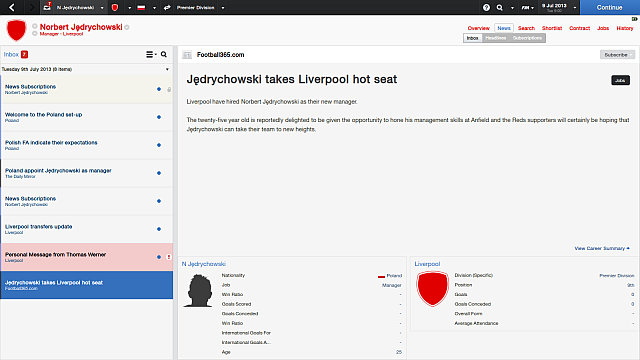 A famous name in a famous club.
A famous name in a famous club.When you start your career in a new club, you often don't know where to start because in the beginning you don't get access to all tactical tools, training preferences etc. If you don't want to get lost in the vastness of possibilities, you should check out the list of things to start with so you can be like Jose Mourinho.
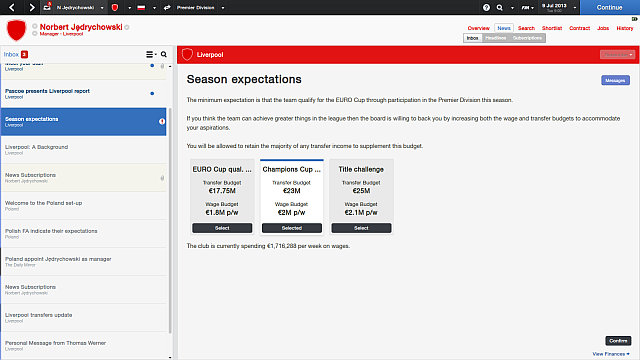 The Champions League Cup is an absolute minimum!
The Champions League Cup is an absolute minimum!1. Choosing expectations for the season
It's the moment when you have to set a goal which you will pursue. Choosing expectations depends on a team that you manage. A beginner should aim for staying in the league, not winning cups. The choice is linked to two things: amount of money that the board will spend on budgets: transfer and wage and how you'll be seen if you don't accomplish the goals. Choose realistic goals so you don't find yourself in a situation when you want to fight for the cup and you're in the lower part of the ranking. The board definitely won't like it.
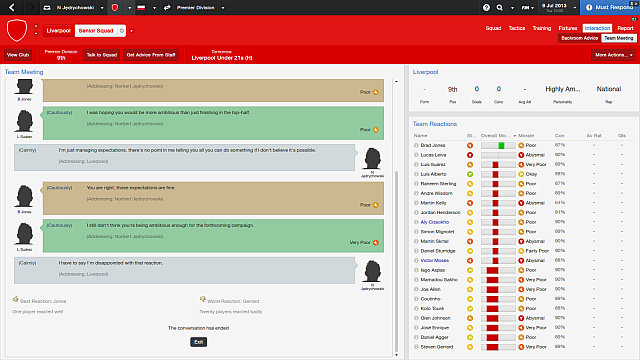 I think you've missed my point...
I think you've missed my point...2. Meetings
Meetings with the board, assistant, journalists, team and the coaching staff are another important element. They will help you get to know the conditions in the club. You'll get team reports from the assistant, and some hints, often very useful, from the board. Pre-season talk with the team will boost their morale and cheer them on (or the other way, when, for example, you set your goal to "just" qualify for EURO cup when talking to a team that has a chance win a championship - the players might think that you're not ambitious enough). It's a good idea to appear in the media from time to time.
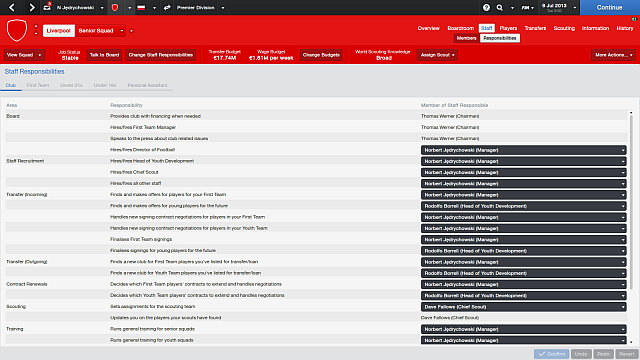 You can see who's the boss here.
You can see who's the boss here.3. Staff responsibilities
Go to Staff responsibilities under the club menu to decide who's responsible for some tasks in your club. You can delegate some responsibilities (like contract renewals) to your assistants, you can also choose to manage the under 18s team yourself. You should mainly pay attention to the First team tab, where you can command your assistant to participate in conferences, do the pep talks and organize friendly matches.
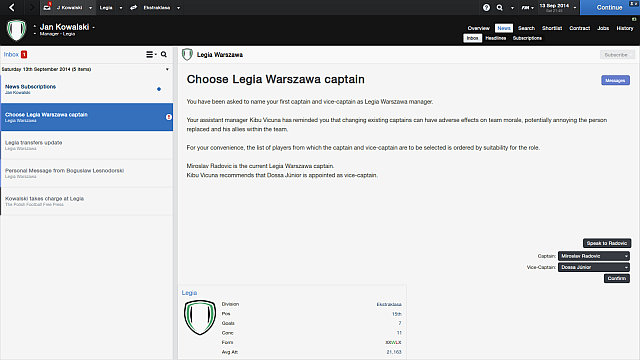
4. Choosing team captain
In the beginning of your career in the club and every season you'll be asked to choose a captain. Of course you can change a captain during the game, for example when the current one is seriously injured. To do it, go to Tactics->Captains. Changing the captain may have a negative impact on the team, especially if the previous captain had this title for a long time and has teammates' support. It will, however, have the biggest impact on the previous captain himself. Talking to him and warning about taking away his armband may reduce the negative effects. When choosing a captain, consider player's leadership and determination. The higher these values are, the better the captain.
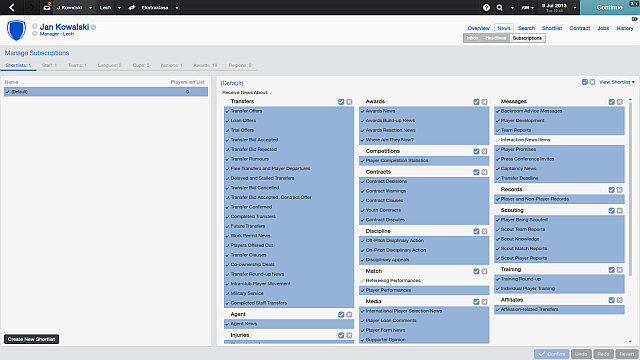 Reducing "spam" greatly improves clarity of the inbox.
Reducing "spam" greatly improves clarity of the inbox.5. Subscriptions
Setting the messages that you want to receive properly lets you avoid dozens or even hundreds of emails that you simply don't want to read. You can miss an important message. To avoid that, go to Manage subscriptions in the options and choose only the subjects of messages that you want to receive. Yay! No spam.
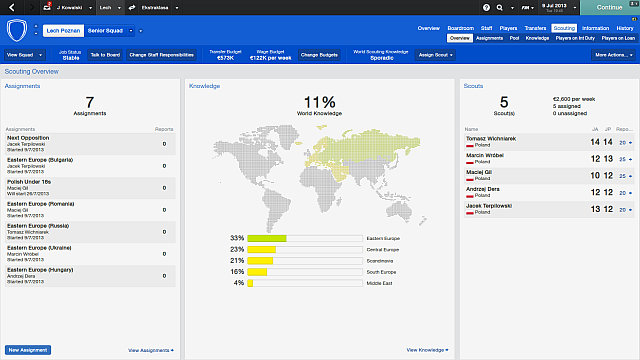 World knowledge almost like in the Middle Ages.
World knowledge almost like in the Middle Ages.6. Scouting
A proper base of scouts will provide constant reports, sometimes about the next opponent, sometimes about some talented young boy from Africa. Properly distributed tasks let you discover very good players, often quite cheap, so you can strengthen your team at low cost. Try to expand your scouting network, the best way (but also hardest and most expensive) is to search all the world so right after a new star is born in Brazil, you sign a contract with him and you know everything about your enemies even before the match starts.
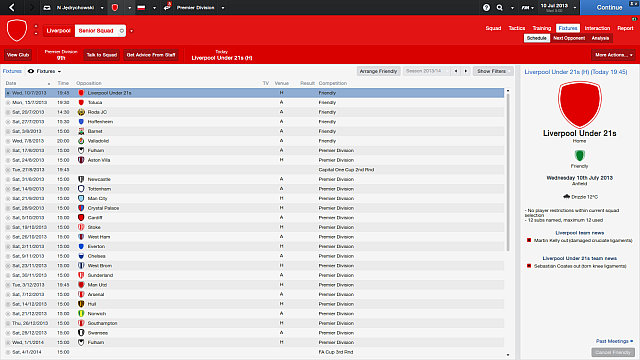 Friendly matches are a great way for testing your team before the season.
Friendly matches are a great way for testing your team before the season.7. Friendly matches
If you didn't command your assistant to arrange friendly matches, you have to take care of it yourself. To do it, go to Calendar->Arrange friendly. It's a great way to test your team or some tactics, or to let the young, untrained players gain some After taking up a job in a new club it's a good idea to arrange a match with a U-21/U19 team etc., perhaps you'll find new, interesting players for your first team.

Tactics are the most important, along with the team, factors affecting the victory. Repeatedly, there are surprising match outcomes in football, when a weaker team demolishes a stronger one. To do it, you need to have proper tactical principles, formation, commands etc. Experimenting with strategy, players and their tasks is the best way to choose proper tactics. This way, by trial and error, everyone can choose right tactics for their team.
For every match you can have one main strategy and two alternative ones that your players can learn during trainings. You can see a bar that represents the players' knowledge of a specific strategy below it. The rule is simple - the more they know it, the better they play. Changing strategy too often may cause your players to play below their best in every formation.
Using the Tactics creator is a fast and easy way to create a proper tactic, you can get to it from a menu in the Tactics screen. It lets you easily, step by step, choose a formation, command the team and choose player roles for each position.
A proper formation is the first element of a good tactic. From a Formation menu you can choose the option you want. You can choose from basic formations like 4-4-2, 3-4-3, and more "fancy" ones, for example 4-2-2-2. Each of them has pros and cons. You can see the picture of a formation on the right. If you want to make changes in a chosen formation (for example move your defence a bit higher), you can do it by clicking the position with LMB and move the "t-shirt" somewhere else, creating for example a 6-0-4 formation.
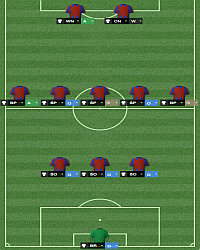
3-5-2
Offensive formation. Side backs are very important, they should be fast and have high value of marking. Well trained midfielders and side midfielders that are fast and good at crossing and passing are also important.

4-4-2
Standard formation, not really offensive or defensive. A balance between offence and defence brilliant in its simplicity. Depending on your style of playing, the most important players will either be fast side midfielders or technically trained central midfielders. It's a good idea to experiment with this formation, play with attacking midfielder or defensive ones. It's great for your first attempts at choosing tactics because of its balance.
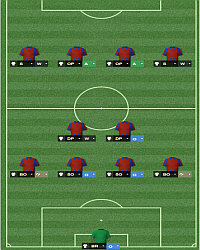
4-6-0
Strong formation, defensive and offensive, without a classic second line. Risky playing and long passes towards attackers should be essential for this formation. Defensive midfielders are important in the team, they are the playmakers. Side midfielders should have high crossing and passing.
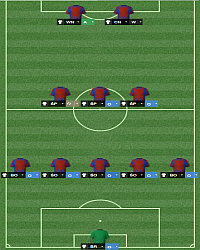
5-3-2
A rather defensive formation, playing from counter attack, mainly for teams without good side midfielders. They should be replaced by side defenders that also take part in offensive actions on the sides. The rest should be in the center, it's good to have a good center midfielder that becomes a playmaker.

5-4-1
Also a defensive formation oriented on counter attacks, however side midfielders can lead the play on the sides. To score goals in this formation, you'll need a very good attacker who can cooperate with the midfielders.

4-2-2-2
Formation for teams that like to play in the center of the pitch. Defensive midfielders should support the team - both in attack and defence. You'll also need fast side defenders who can take the action to the attack line.
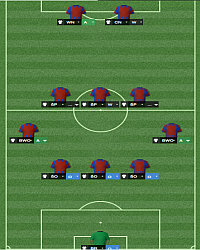
5-3-2
This formation should be used along with offensive mentality of the team. It provides a balance between defence and attack. The most important players are side defenders who should play mainly offensive. They should have good speed and crossing.
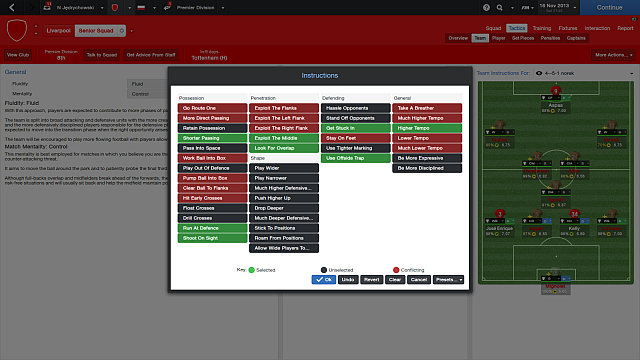
You can choose team instructions in Tactics->Team. They determine your team's general style of playing. You should spend some time to give the right instructions - without them, your players will never play at their best.
Detailed description below.
Style
You may choose from: Very rigid, Rigid, Balanced, Fluid, Very fluid. From left to right, the more rigid style, the less freedom the players have on the pitch. Defenders will only defend, attackers - attack. If you choose a more fluid style, the players will have more tactical freedom - attack will more often turn into defence and vice versa.
Mentality
Contain - very defensive mentality, all players focused on keeping the ball and not letting the opponent score. Very useful at the end of the match, when you want to keep the score as it is. Defensive - also a defensive mentality, however the players will pass the ball to attackers for a counter attack. Counter - defensive playing on your side with looking for an opportunity to counter, defenders take part in the action. Standard - Balance between offence and defence. Control - mentality mainly for teams that keep the ball, setting the game's pace. It's an offensive mentality, effective against teams that prefer counters. Attack - more offensive mentality, recommended against weak opponents to push them into defence. Be careful not to get countered. Overload - mentality for the end of the match, when you tell all players to attack, hoping to score a goal.
Instructions that you can give to the team concern several aspects like Possession or Defending. Remember that choosing some of them collides with other. For example, if you select Float crosses, it conflicts with Drill crosses, Get stuck in conflicts with Stay on feet etc.
Full list below.
Go route one
Immediate, fast getting the ball into the attacking third, may result in scoring an unexpected goal.
More direct passing
Quicker transition from back to front with the ball covering longer distances.
Retain possession
Instructs players to try to keep hold of the ball.
Shorter passing
Shorter, more precise passing, retaining the ball for a longer time.
Pass into space
Passing the ball into free spaces.
Work ball into box
Tiki-taka, a lot of passes, retaining the ball until a breakthrough occurs.
Play out of defence
Instructs defenders to pass their way out from the back without long passes.
Pump ball into box
High, long passes into opposition's penalty area.
Clear ball to flanks
Passing to attackers that wait on the sides of the pitch.
Hit early crosses
Getting the ball into the penalty area as soon as possible.
Float crosses
High, floating crosses with ball hanging in the air, gives your attackers time to position themselves.
Drill crosses
Quick, powerful crosses, good for fast and strong attackers.
Run at defence
Perfect for well-trained players, instructs them to run at the opposition more often than by default.
Shoot on sight
More shooting from outside of the penalty area.
Exploit the flanks
Instructs to take advantage of wide play, useful if you have good side midfielders and defenders.
Exploit the left flank
Wide play on the left side of the pitch, useful when you notice that one of opposition's defenders is weak.
Exploit the right flank
Same as above, just on another side.
Exploit the middle
The team will play in the middle, good when you have an experienced playmaker.
Look for overlap
Players will keep hold of the ball until supporting player comes closer and run around the opposition.
Hassle enemies
Instructs the players to give the opposition little time and space on the ball, attempting to force a mistake.
Stand off opponents
Gives the opponents more time while your players retreat to defence.
Get stuck in
Instructs the players to be aggressive and strong. It increases risk of fouls, so you should watch out for referees who give many cards.
Stay on feet
Players will usually stay on their feet while making tackles instead of going to ground.
Use tighter marking
The defenders will stay close to the opposition in defensive situations.
Use offside trap
Makes your defenders use offside trap. With poor cooperation in your team you risk that you'll fail and the opposition will get to your goal easily.
Play wider
Makes your players look to stretch the pitch and play wider.
Play narrower
Your players will look to narrow the pitch, they will try to play in the middle.
Much higher defensive line
Moves the defensive line towards the middle of the field, it will make intercepting opposition's long passes easier (as long as their attackers aren't faster than your defenders).
Push higher up
Just like the instruction above, it moves the defenders towards the center.
Drop deeper
Moves your players to your side.
Much deeper defensive line
Moves your defensive line as close to your own goal as possible.
Stick to positions
Makes the players stick to their set positions, limits their tactical freedom.
Roam for positions
The players will look for positions, recommended for fluid playing style.
Allow wide players to swap
It allows the players in wide attacking positions swap during the match and stay in their new positions for a while.
General
Play wider
Makes your players look to stretch the pitch and play wider.
Play narrower
Your players will look to narrow the pitch, they will try to play in the middle.
Much higher defensive line
Moves the defensive line towards the middle of the field, it will make intercepting opposition's long passes easier (as long as their attackers aren't faster than your defenders).
Push higher up
Just like the instruction above, it moves the defenders towards the center.
Drop deeper
Moves your players to your side.
Much deeper defensive line
Moves your defensive line as close to your own goal as possible.
Stick to positions
Makes the players stick to their set positions, limits their tactical freedom.

After you choose the general tactics for the whole team, it's time to give your players roles, duties and instructions. To do it, go to the Player tab.
In the upper left corner you can see a thumbnail of your formation. You can give individual instructions for every player in a position by clicking it. In the lower left corner you can give instructions for an individual player. If he doesn't play in the final eleven, his instructions will be replaced by the ones you gave to any player on this position. On the right you can see useful attributes for a player on a specific position (in the screenshot it's Central defender, duty: Defend). At the bottom you can select your individual player's behavior during set pieces (form wall, man mark etc.).
There are descriptions of all possible role on each position, duties and instructions for individual players below.
Defend
It will make the player (regardless of his role) play mainly defensively, leaving attacking to others.
Support
Supporting the attack, the player will play more offensively.
Attack
Players with this duty will play offensively, either supporting the attackers or going to the penalty area by himself.
Stopper
Duty for middle defenders, stopper has to stop the opposition before they reach the penalty area.
Cover
Also a duty for defenders. They will wait behind the defensive line for an opportunity to intercept the ball.
Automatic
His duty is set automatically, based on selected strategy.
Goalkeeper
Goalkeeper's main role. His job is to play the ball away from the goal, either to open players or to opposition's side.
Sweeper keeper
Except for goalkeeper's defensive duties, sweeper keeper plays like a stopper. His task is to intercept balls that go into the penalty area and initiating counter attacks.
Libero
He stays behind the defensive line to cover for defensive errors. If he possesses the ball, he'll support the attackers and step into the midfield.
Sweeper
Stays a little behind the defensive line, he's the last line of defence. Because of that, he should be athletic and have high tackling and heading. He rarely (if ever) ventures forward.
Central defender
A regular central defender. Desirable attributes: tackling, heading, marking. His task is to block passes and playing the ball away from penalty area.
Ball playing defender
Similar to central defender, his main job is defensive playing. Moreover, he performs counter attacks.
Limited defender
His main task is playing the ball away from penalty area. He should have high technical attributes.
Full back
Full back, as a key figure in fast, modern football, should have both defensive and offensive attributes to support his attacking teammates.
Wing back
Similar to full back, however he's usually the only winger, so he has to play all the way to the opposition's penalty area. He'll need high levels of dribbling and crossing.
Limited full back
Wing back, concentrated mainly on staying in the defence, rarely playing in offence.
Complete wing back
A wing back that loves playing offensively, usually also playing in attack.
Defensive midfielder
His main task is a defensive role, which is marking and taking the ball from attackers. When your team has the ball, he helps the wingers that are closer to the opponent's goal.
Deep lying playmaker
His main task is still supporting the defence, however he should be creative and good at passing so he can initiate attacking moves.
Ball winning midfielder
The player on this position must be able to take the ball from the opposition, he also should have high bravery to keep hold of the ball afterwards.
Anchor man
Mainly defensive. Good tackling, avoiding offensive playing and sticking to a position are essential.
Half back
Player on this position goes back to defence so more offensive defenders may move forward.
Regista
A more aggressive version of half back who can additionally control the team's play.
Central midfielder
Classic central midfielder, depending on a task he's expected to take part in either offensive or defensive situations. He should also be able to do long shots and free kicks.
Box to box midfielder
A midfielder who supports both offence and defence, he moves around all of the field. It's very important to prepare his physical abilities because he runs more than the others.
Advanced playmaker
He plays between the opposition's defence and your midfielders, where he can control the team's play and take part in offensive situations.
Winger
He moves offensive situations along the side of the field and plays ball into the penalty area. He should be good at dribbling and crossing.
Wide midfielder
A link between offence and defence. He should be good at tackle and passing so he can pass the ball to wingers.
Defensive winger
His job is to receive the ball as far away from his penalty area as possible and keeping it there until supporting players come. He also passes to the attackers in the penalty area.
Offensive winger
A winger moved to the front whose main task is to control the game and initiating offensive situations near the opposition's penalty area. Desirable attributes: technique, flair.
Deep lying forward
A link between midfielders and offence. He holds the ball and plays it with offensive wingers. It's his job to hold the balls and to play them with offensive helpers and to lead the teammates from the attack into an alley.
Advanced forward
Offensive player, he's supposed to score goals, assist and finish actions after long passes.
Target man
Target man's main task is to intercept the ball and pass it to his nearest teammate.
Poacher
Poacher has to score goals. He stays in the penalty area, waiting for an opportunity to shoot.
Complete forward
Somewhere between advanced forward, target man, and a poacher. He must be perfectly trained, both technically and physically.
Defensive forward
Defence starts in attack so he will intercept the ball and try to exhaust the opposition's defence.
Trequartista
Very offensive player, he can be either advanced forward or an offensive midfielder. His main task is to initiate plays and offensive actions.
False 9
This player will move towards the middle of the field, making the opposition's defenders chase him and therefore creating gaps in their defence.
Inside forward
A forward that goes from the side to the penalty area. His main task is initiating plays and crossing into the penalty area. His better leg should be opposite to the position he's on.
Wide target man
A target for defenders' long passes. His task - intercepting, keeping and then playing the ball. He should be good at heading and crossing.
Every player instruction is set for a position, unless you select it for an individual player - other players on this position will have default instructions. They are an important addition and it's a good idea to match them to the roles and duties described above.
All individual instructions below.
Hold up ball
The player keeps a hold on the ball for a longer time, slower play.
Shoot more often
Instructs the player to shoot more often.
Shoot less often
Less shooting, more passes to teammates in better positions.
Dribble more
The player will be more individualistic and try to get past the opposition by himself.
Dribble less
Instructs the player to pass more instead of trying to beat the opposition by himself.
Run wide with the ball
Play wide.
Cut inside with the ball
Cross the ball from sides.
Pass it shorter
Shorter passes and creating the play patiently.
More direct passes
The players will take more risks when passing.
More risky passes
The players will try to play low-percentage passes hoping that one or two of them will unlock the opposition's defence.
Less risky passes
Players will play sensible and patient passes.
Cross more often
Encourages the player to cross more often.
Cross from deep
Instructs to cross from deeper parts of the field instead of waiting for the ball to be in the attacking third.
Cross from byline
Opposite situation. Asks players to get the ball as high up the pitch as possible.
Cross aim near post
Deliver crosses into near post area.
Cross aim centre
Deliver crosses into centre of penalty area
Cross aim far post
Deliver crosses towards the far post.
Cross aim target man
Deliver crosses towards a designated target man.
Take quick throws
Quicker throws allowing a more dynamic play.
Take long kicks
Instructs the goalkeeper to kick the ball far from the goal, directly to offensive players.
Distribute to defenders
Asks the goalkeeper to seek a short pass to a defender.
Distribute to a specific teammate
The goalkeeper will pass to a selected player.
Get further forward
Instructs players to play more offensively and go towards the opposition's side.
Hold position
Asks the player to stay in his position.
Stay wider
Instructs players in wider areas to stay as close to the touchline as possible.
Stay narrower
Encourages players to stay in the center of the field.
Move into channels
Players will find spaces between opponents to seek for a pass.
Roam for position
Lets the player roam freely to choose a position to find a better placement.
Close down more
Harassing opponents who possess the ball to force a mistake.
Close down less
Retain a defensive shape so the opposition don't break you down.
Tackle harder
Play more aggressively, with more determination.
Ease off tackles
The player will avoid aggressive playing to reduce a risk of fouls.
Mark tighter
Instructs the player to stay close to the opponent and make it impossible for him to play effectively.
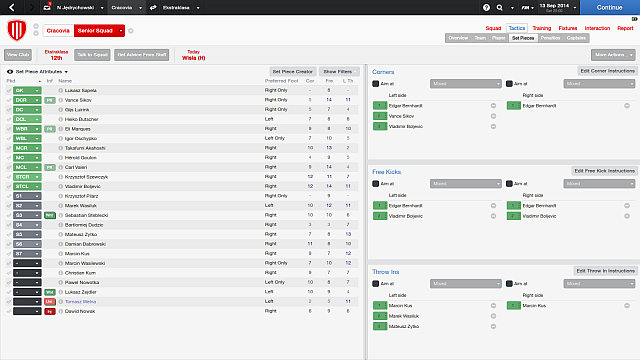
Set pieces are arguably very important in modern football, so you shouldn't ignore this element in Football Manager. Placing the team properly during defensive free kicks and corners will lead to losing less points. Offensive set pieces are sometimes the only way to score a goal.
Main types of set pieces:
1. Free kicks (offensive and defensive)
2. Corners (offensive and defensive)
3. Throw-ins (left and right)
4. Penalty kicks
You can change preferences of set pieces with SP Creator.
Detailed description of preferences below.
You can change the way of doing free kicks on both left and right side. Combining it with instructions for individual players is a key element, essential if you want to score goals in free kicks. Placing the players correctly during defensive free kicks will prevent the opposition from scoring. Remember to pick the right players for that, the most important attribute is obviously Free kicks.
List of settings below.
Attacking free kicks
Mixed
Computer decides.
Short
Playing to the nearest teammate.
Long
Playing further forward
Near post
Playing towards the near post.
Cross centre
If possible, crossing into the penalty area.
Far post
Playing towards the far post.
Best header
Attempt to play to the teammate who's the best at heading.
Players' behavior during attacking free kicks
Default
Computer will place the player according to tactical settings.
Stay back
The player will stay back during a free kick.
Stay back if needed
The player will stay back only if he's needed to (for example, to mark an attacker).
Disrupt wall
The player will look to disrupt the defensive wall.
Mark keeper
The player will try to stand in front of the goalkeeper to obscure his view.
Stand with taker
The player will stand near the free kick taker to provide help if needed.
Default
Computer will place the player according to tactical settings.
Stay back
The player will stay back during a free kick.
Stay back if needed
The player will stay back only if he's needed to (for example, to mark an attacker).
Disrupt wall
The player will look to disrupt the defensive wall.
Players' behavior during defending free kicks
Default
Computer will place the player according to tactical settings
Go back
The player will go back towards the goal to mark the incoming attackers.
Stay forward
The player will wait near the penalty area for an opportunity to counter.
Man mark
The player will mark an attacker.
Form wall
The player will stand in the wall.
Stand on near post
The player will stand on near post.
Stand on far post
The player will stand on far post.
You can change corner settings for left and right side. During defence, placing the players properly and giving correct instructions are essential. To score goals, you also have to pick a player with high level of Corners.
List of available settings below.
Attacking corners
Mixed
The player will choose where to play.
Short
Playing to the nearest teammate.
Near post
Playing towards the near post.
Far post
Playing towards the far post.
Penalty area
Playing into the penalty area.
6 yard box
Crossing into the 6 yard box.
Players' behavior during attacking corners
Default
Computer will place the player according to tactical settings
Stay back
The player will stay back in defence.
Stay back if needed
The player will stay back only if it's necessary (for example to mark the attacking opponent).
Go forward
The player will move into the penalty area.
Attack near post
The player will look to attack the near post.
Attack far post
The player will look to attack the far post.
Near post flick on
The player will attempt a near post flick on.
Stand on far post
The player will stand at the far post.
Attack ball from deep
The player will attempt to attack the ball from near the penalty area.
Challenge keeper
The player will try to challenge the goalkeeper and distract him.
Lurk outside area
The player will stand in front of the penalty area.
Offer short option
The player will move near the corner of the field to help the teammates.
Players' behavior during defending corners
Default
Computer will place the player according to tactical settings
Edge of area
The player will stand outside of the penalty area, around the 16th meter.
Go back
The player will go back but stay in the penalty area.
Stay forward
The player will stand far from the penalty area, hoping for a counter.
Man mark
The player will mark the opponents.
Mark near post
The player will defend the near post area.
Mark far post
The player will defend the far post area.
Mark tall player
The player will try to mark one of the tall players.
Mark small player
The player will try to mark one of the shorter players.
Close down corner
The player will stand near the taker to make a short pass impossible.
Mark six yard box.
The player will mark the opponents inside the six yard box.
An underestimated part of the game. Performing a throw in correctly will let you initiate an offensive situation or take a defender out of the penalty area. Important attribute: Long throws.
List of preferences below..
Throw ins
Mixed
The player will decide how to perform the throw in.
Short
Playing to the nearest teammate.
Long
Playing further forward.
Quick
Performing the throw in a quickest possible way.
Players' behavior during throw ins.
Default
Places the player according to tactical settings.
Stay back
The player will stay back during the throw in.
Come short
The player will stand near the touchline as a pass option.
Lurk outside area
The player will wait for a pass near the penalty area.
Near post
The player will stand at the near post.
Forward
The player will move forward to an attacking position.
There's nothing to show off here. Every penalty kick should result in scoring a goal. To do it, it's essential to choose the right player for this set piece. The most important attributes are obviously Finishing, Composure and Penalty Taking. The player you choose should have these attributes at highest possible level, especially Penalty Taking. It's a good idea to choose more players so that nobody with lower skills would do penalty kicks.
If you defend, it's a game of chance, believe in your goalkeeper's skills and lack of attacker's composure.
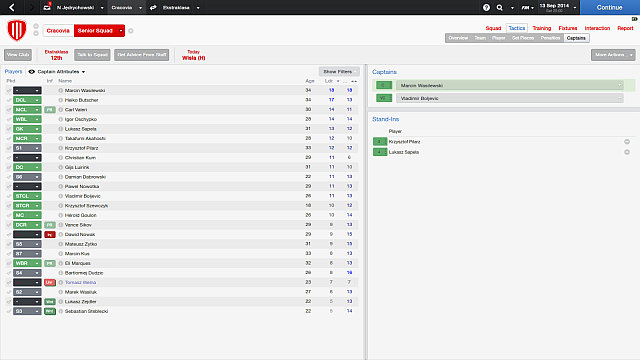
The last factor that may guarantee a series of victories and successes is choosing a right captain and his deputees. You should consider a few attributes:
1. Age - The captain shouldn't be too young. Choose an experienced player in his best age (26-32 years old).
2. Experience in the club - The player that gets the captain's armband should play in your club for at least few months.
3. Favorite teams - It's not really important but your captain's favorite teams should not be your enemies.
4. Personality - Avoid emotionally unstable players, the captain should be a professional, balanced player.
5. Mental attributes - Traits like leadership, determination, work rate and bravery should have the highest values possible.
Choose a vice-captain and 2-3 deputees using the same rules. That way, when your captain can't play in a game, you'll have properly prepared players. When you choose a captain, try to pick a player that will stay in your team in the nearest future.

Your players train almost every day, except for breaks between seasons, periods of recuperation and days of rest that you give them so it's an important part of managing a team. Training lets you prepare your players and, what's more important, increases levels of their attributes.
Training can be divided into three aspects: whole team's general training, training before matches and individual players' training. In the following chapters you'll find description of all these types.
Remember: if you're not very good at choosing a training or you just don't want to take care of it, you can delegate it to your staff. To do it, go to Staff responsibilities, then find Training options. You can give all the aspects mentioned above to your staff or, for example, manage only individual training yourself and delegate the rest to your assistant.
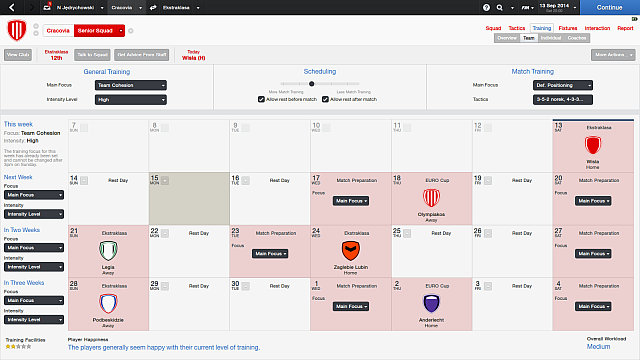
Team training is a general form of training for all of the team. In its options you can change training's frequency and time proportion between match and general training. Moreover, you can choose a few days off for your team if you want.
It's a good idea to change the main focus according to your needs and strategy. You can set main focus for each week and change intensity. You should for example lower the intensity or give your players a day off when they're going to play two matches in a short time. You should also consider ticking a day off before and after a match. You shouldn't overwork your players because it leads to lowering their fitness and happiness, and finally to playing worse.
Differences in main focus:
Balanced
All attributes are practiced, no focus on a specific one.
Fitness
Focus on fitness, strength and general condition. Mainly following attributes: Strength, Agility, Balance, Acceleration, Jumping reach.
Ball control
Focus on technical attributes, mainly: Dribbling, Technique, First touch, Heading.
Tactics
Focus on tactical attributes, mainly: Anticipation, Composure, Teamwork, Decisions and Concentration.
Defending
Focus on playing in defence, mainly: Marking and Tackling.
Attacking
Focus on offensive attributes like: Finishing, Long shots, Passing and Creativity.
Team cohesion
The training won't focus on improving specific attributes but on team cohesion, which leads to keeping a high morale, improving communication between players, relations in the team and finally to better cohesion and playing.
Pick a training that matches your needs. A few examples below.
1. You use mainly defensive strategy, playing counters so focus on practicing defense and condition.
2. You play offensive, fast football your priorities should be offense and controlling the ball.
3. You want high possession -focus on controlling the ball mixed with playing offensively or defensively depending on the style you prefer.
Properly selected training will improve mainly the attributes you want. It's a good idea to take a look at team cohesion, especially between the seasons and when you get new players.
Training intensity - time and energy your players spend to increase their attributes. The more intensity you set, the more tired the players will be. You should stick to the rule of setting the biggest possible intensity that keeps players happy. You can check overall workload in the lower right corner. If most players are happy with their training, you shouldn't change intensity for the team, just lower it for players who aren't content. You should also lower intensity during weeks with 2 matches, in favor of match training. Remember to keep your players happy and not exhausted and everything will be alright.
After finishing the season, your players will go on (more or less deserved) vacations. They won't train all this time. When they return to the club, their attributes will be a bit lower and their form won't be at their best. To prepare your players for the season, you have to mostly take care of their form. To do it, set their training intensity to very high and focus on fitness. Watch as their fitness for the season increases until they're ready. Then you can set the training to any focus you want. Don't forget to practice team cohesion, especially when you have new players.
During the match training your players practice selected elements to prepare for meeting the opposition. You should set your match training for every opponent and strategy you're going to choose for the match. In the Scheduling bar you can distribute time between match training and general training. It can be up to 50% for each. You can also ignore match training and focus on general one. It can be useful during weeks with more matches.
Focus options in match training:
Tactics only
Focus mainly on tactical preparation. The players will practice your tactics, and when they understand it, they play better.
Teamwork
The training will focus on teamwork and concentrating communication on the field so everything runs like a clockwork.
Def. positioning
Your players' defensive attributes will increase for a moment. It's good to use this option when you're going to play against stronger opponents and you plan to play from counters.
Att. movement
Offensive attributes will increase. Use this option if you're going to play against weaker enemies and you want to push them into defence.
Def. set pieces
Focus on defensive set pieces. Use it if you lose a lot of points during set pieces.
Att. set pieces
Focus on attacking free kicks and corners. Recommended against strong enemies, where set pieces may be the best (or only) way to score goals.
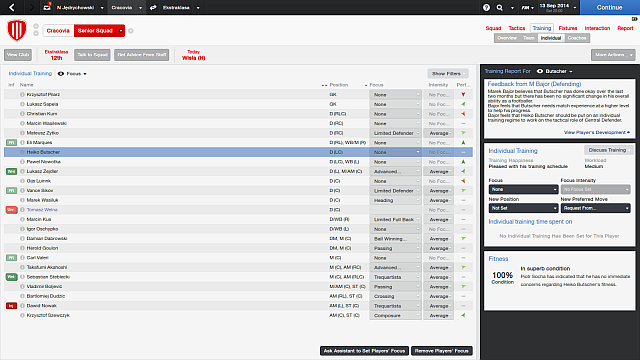
After selecting a general training for the whole team, it's time to set individual training for each player. You can divide it into 3 aspects: position, selected attribute/role and preferred moves. You can set intensity for any individual player, pay attention to it to make everyone happy with their training. Moreover, by selecting training of a preferred move or a new position, you'll make the training distribute evenly. Set as high intensity as possible while keeping the players content for the biggest increase in attributes.
Individual training lets you select an attribute on which your player has to focus. Thanks to this option, you don't have to increase defensive training for all team just to improve single player's marking. Role training depends on the player's position and teaches him attributes needed for a specific role (all of them described in Tactics chapter). Obviously, not every attribute can be trained.
Goalkeepers: first touch, free kicks, handling, kicking, penalties, throwing, composure, leadership, positioning, agility, balance, jumping reach, quickness, stamina, strength.
Field players: corners, crossing, dribbling, finishing, first touch, free kicks, heading, long shots, long throws, marking, passing, penalties, tackling, technique, composure, leadership, off the ball, positioning, agility, balance, jumping reach, quickness, stamina, strength.
Positioning, off the ball and marking are available for teams with at least good training base.
Position training has to teach a player to play on a new position. It's useful when you don't have many players, it's expected from a player to be able to play on more than one position. Check player's best positions on his profile.
You can describe player's abilities on a specific position as:
Natural
Natural position for a player, he'll be best at it.
Talented
Not a natural position but the player will still be very good at it.
Competent
The player may be successful on this position, however you shouldn't expect incredible results.
Doubtful
The player will meet the expectations only for a short time.
Inept
The player will play poorly while getting used to unnatural position most of the time.
Talentless
The player shouldn't be on this position at all, only if you don't have anyone better.
Remember to select a proper position training for the player's attributes. You shouldn't try to turn a natural attacker into a central defender. Consider player's age - it's much easier to teach a new position to a young beginner.
In the player's tab you can see his preferred moves, you can teach him new ones or delete the unwanted ones through interaction with coaches. Do it by selecting New preferred move in the individual training menu. For goalkeepers, the selection of moves is limited - they can perform free kicks and avoid/practice playing with their weaker leg. Remember that you can't change every player's moves, sometimes attempts in doing so will result in failure.
List of recommended moves for each position.
1. Central defenders
-tight marking,
-avoiding or choosing to throw himself into tackles,
-passing to teammates on better positions,
-playing straight passes,
-playing in attack more often,
-avoiding/practicing playing with their weaker leg.
2. Side defenders
-tight marking,
-avoiding or choosing to throw himself into tackles,
-passing to teammates on better positions,
-playing in attack more often,
-sticking to touchline,
-running forward with the ball,
-throw ins into penalty area,
-avoiding/improving playing with weaker leg.
3. Defensive midfielders
-tight marking,
-avoiding or choosing to throw himself into tackles,
-playing in attack more often,
-passing to teammates on better positions,
-slowing the tempo,
-avoiding/improving playing with weaker leg.
4. Central midfielders
-playing in attack more often,
-passing to teammates on better positions,
-slowing the tempo,
-long free kicks,
-more long passes,
-forced free kicks,
-long shots as often as possible,
-avoiding/improving playing with weaker leg.
5. Wingers
-playing in attack more often,
-passing to teammates on better positions,
-running forward with the ball,
-attacking wide more often,
-sticking to the touchlines,
-passing the ball to the other side,
-more long passes.
6. Attackers
-long shots as often as possible,
-stronger shooting,
-shooting near the ground more often,
-going around goalkeepers,
-trying to soot on first touch,
-Shooting from overhead kicks as often as possible,
-going around enemies by playing into a free area,
-going into the centre of the penalty area,
-improving playing with the weaker leg.
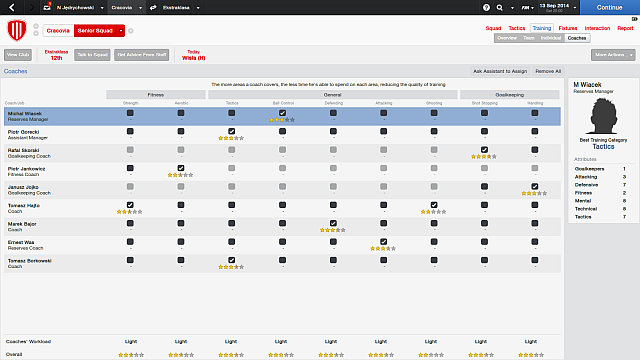
In the Coaches tab you can delegate specific parts of training to your coaches. At the bottom you can see overall workload in a specific aspect of the game.
You can delegate coaches to these areas:
Fitness
General
Goalkeeping
Strength, aerobic
Tactics, ball control, defending, attacking, shooting.
Shot stopping, handling.
You can leave it to your assistant as well.
People responsible for training:
Assistant
Might be responsible for any type of training
Coach
Likewise, any type of training.
Fitness coach
Responsible for fitness training only.
Goalkeeping coach
Responsible for goalkeeping training only.
Aside from these people, you can assign coaches and managers for junior teams. You'll be most effective when you assign only 1 aspect of training for a coach. It's often impossible because of budget or the board's limitations. To check the number of coaches allowed by the board, go to Boardroom.
While hiring coaches, pay attention to their attributes. The coach with best tactics should take care of tactics, not, for example, defence. Use their attributes to make training effective.
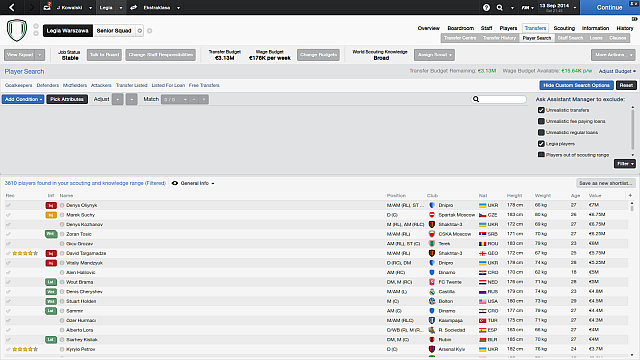
There's a time for changes in every manager's life. One of these periods is obviously transfer window. If you don't have any player that you want to buy or your scouts gave you too little report, you should take a look at Player search.
You can search players by their positions, age, attributes or contract status. It's a good idea to scout a player before negotiations to see if he's going to be useful in the team. Your assistant may filter some results and not show you unreal transfers, your own players or the ones out of scouting reach. Sometimes you may succeed in convincing someone marked as an unreal transfer to move to your club, however it's not easy and costs quite a lot.
Offering trial is a good way to test a player before signing a contract. Remember that he can't play in matches for money so you should arrange a friendly match during the trial.
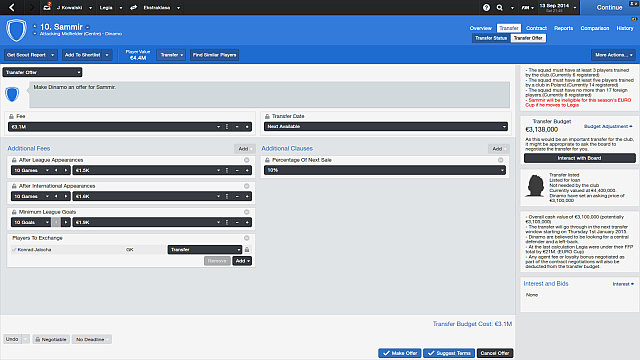
When you choose a player you want, who has a contract with another club, you can proceed to negotiations. Offering a fee equal to the player's value will very often result in a refusal, the fees might be a lot higher. Prepare for long, tedious negotiations, try to negotiate slowly, raising the offer as slowly as possible, so you don't overpay.
Possible options during negotiations:
Fee
The money you pay when you buy a player.
Transfer date
You can choose between the nearest possible (usually end of season) or immediate (available in the transfer window).
(Non)negotiable
Negotiable - Your offer may be modified and the club will make their offer. Non-negotiable - the club will either accept or refuse your offer.
Deadline
Time for the club to answer. You should give them at least a week.
Additional fees that may convince the club to sell their player:
Monthly installments
Simple - you pay every month (for example 12M in 12 months - 1M per month). Don't buy too many players with monthly installments, you don't want your club to go bankrupt.
After league appearances
After a certain number of appearances in a league, the club will get a fee.
Per league appearance
The club will receive a fee for the number of his appearances (for example 20 appearances for 1K).
Per national team appearance
Likewise but the player must appear in the national team instead of league.
Minimum league goals
The club will get money after the player scores a certain number of goals.
After promotion
Available in lower leagues. You pay the fee after getting a promotion.
Players to exchange
You offer another player, either in addition or instead of the money. Both players must sign contracts to complete the transfer.
Additional clauses that may convince the club to sell their player:
Percentage of profit from next sale
The percentage of profit earned by selling the player. For example: you buy the player for 1M, sell him for 5M, you pay a percentage of profit - in that case your profit is 4M.
Percentage of next sale
You may lose more here. You pay a percentage of all the money you get from selling - in that case 5M.
Buy back price
Amount of money that the club will be able to buy the player back for.
Arrange friendly
A friendly match as a celebration of a successful transfer.
You can also loan a player for some time after setting some conditions. The basic ones are obviously monthly fee, percentage of wage you'll pay and duration.
Additional clauses and options below:
Future fee
Fee that the club has to pay to get the player back during the loan.
Squad status
Status that the player will have in your team.
Preferred position
Position that you're going to give him.
Can play in cup matches
Player's availability in cup matches.
Can play against own team
Player's availability in matches against his own club.
Can be recalled
Option that lets the club take the player back before the end of the loan.
Co-ownership is popular mainly in Italy and South America. Two clubs share ownership of a player (usually 50% each). If you want to buy such a player, you have to negotiate with both clubs. It's a good way to quickly earn some money, for example by selling half of a player and leaving him in the club until the end of the season. Then you negotiate and who gives more money, keeps the player.

Finishing negotiations are not the final point, you also have to negotiate the player's contract.
Main terms of contract:
Contract type
Type of contract for the player (professional, junior).
Job
In these negotiations it's a player, of course. Retiring players can be hired as future coaches.
Squad status
Indispensable - main player, star of your team, appearing very often in the main eleven. Important first team player - also main player, he can take a rest more often. Used in squad rotation system - player used in rotation, often in the first team. Backup to the first team - he enters the field when you don't have better players. Hot prospect for the future - a young player who has a chance of making his way to the first team. Decent young player - a young player from whom you don't expect too much. Not needed by the club - a player you want to get rid of. Of course impossible to offer during negotiations.
Transfer date
When the contract starts
Contract length
Duration of the contract
Wage
Wage for the player. Players with better status expect a better wage while being more interested in changing a club.
Loyalty bonus
Bonus paid during the contract. If you sell the player earlier, you won't get part of it.
Fee for agent
Fee for the player's agent. They are often greedy but a proper payment will provide a fluidity of negotiations.
Bonuses for players.
Appearance fee
Bonus for every match played during a season
Goal
Bonus for scoring a goal.
Clean sheet
Bonus for a goalkeeper for finishing a match without losing points.
Team of the year
Bonus for being chosen for the league's team of the year.
International cap
Bonus for every game in the national team.
Bonus for unused substitute
Bonus for matches spent as a substitute without going on the field.
Clauses - the last element of negotiations.
Minimum fee release clause
You'll be forced to accept every offer of buying that matches a set price.
Relegation release clause
The player will be able to leave your club for a set amount of money if you're relegated to lower league.
Yearly wage rise
The player's earnings will be increased by a percentage of his wage. Be careful with long-term contracts, every year you'll pay more (percentage of increased wage).
Sell on fee percentage
After a next transfer, the player will get a selected percentage of fee.
Seasonal landmark goal bonus
Bonus will be paid after shooting a selected amount of goals during the season.
One-year extension after league games (final season)
In the final season of the contract, when the player appears in a selected number of matches, his contract will be extended automatically.
Match highest earner clause
The player's wage will match the wage of the highest earner in the team.
Wage after reaching club career league games
After a set amount of appearances, player's wage will increase.
Top division relegation wage drop
Player's wage will drop in case of relegation.
Minimum fee release clause (foreign clubs)
Minimum fee release clause for foreign clubs.
Minimum fee release clause (domestic clubs)
Minimum fee release clause for domestic clubs.
Extending by the club
This clause lets you extend the contract at any time.
Pay attention to what you offer to the player. Right clauses and bonuses can be a good way to convince him to go to your club. Check which ones are the best for you.
If you want to avoid the ridiculous terms of agents, try to look for players without agents. Most good player have them so you have to search for young ones.
During the contract negotiations, you'll very often have to deal with agents. They're responsible for negotiations (of course they take money for that). The more successful negotiations you had with an agent, the more chance that next ones will be successful too. When you read an agent's profile, you'll see if he tries to sell players at all cost, if he's patient etc.
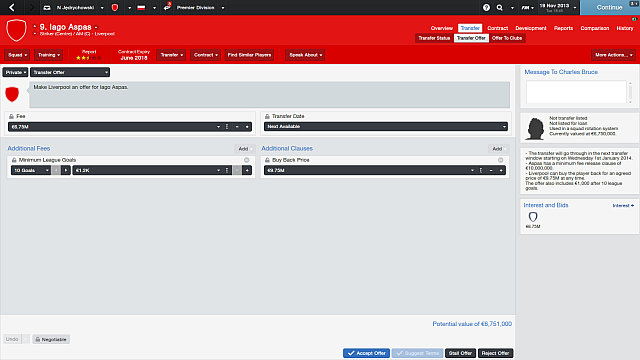
Sometimes, instead of buying, you'll have to say 'farewell' to some players. There can be many reasons: fixing budget, player's need to leave or just getting rid of a weak player. The main way of getting rid of players is selling them, however you can terminate the contract or fire the player.
The most profitable option. If you want to get rid of a player, add him to a transfer list and make offers to clubs. If you want to do it really fast, you should lower his price. If you sell young players with perspectives, think of a fee to buy them back. Take care of percentage from next transfer, if the player's value increases, it will give you quite a lot of money. Remember that you won't get all the money, just a percentage of it. You can check how much in Finances.
Options and clauses are the same as when you're buying a player, the only difference is that you get money, not pay.
Another way to get rid of an unwanted player is terminating his contract. You can choose Free termination that ends his contract. It's quite an expensive solution because you have to pay him a compensation. Moreover, if you want to fire a good player or the compensation is too high, the board may not agree. Another option that you can choose is mutual termination but the players rarely agree to it.
It's better to sell a player, even for too little, than to terminate his contract because if you do it you get money instead of losing it.
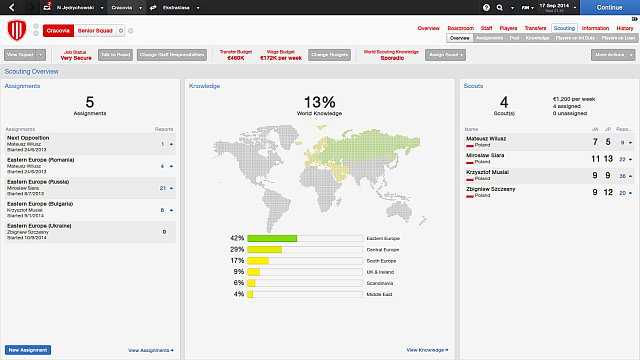
Proper preparation for the match is essential if you want to win. You should know as much as possible about your opponent a few days before the match: his formation, best player, strongest side, what his players have for breakfast etc. You'll get this information from your scout's report, it's prepared before every match (if you tell at least one of your scouts to monitor your opponents).
Description of scout's information below.
Scout's report
1. Squad personality
It shows a description of all players with evaluation of their skills and opinions about them. You can also see what roles are assigned to specific players and compare them to your ones.
2. Tactics
Here you can see your opponent's strategy, how many goals they score and lose and a comparison to other strategies. You should take a look at formations against which they score and lose most goals.
3. Goals
This tab shows you information on the opponent's scored and lost goals. You can see how he shoots/loses and his assists. There's also a percentage of goals scored in several parts of the match (90 minutes divided into 6 15-minute periods). It can be really useful - for example, you should attack during a time in which your opponent loses most goals.
4. Last match
Here you can see a summary of your opponent's last match. There's the score, summary and assessment of individual players. You'll see how fit the opponent is. You should also check his last opponent.
5. Comparison
An important element where you can see a comparison of your and your next opponent's attributes. Take a look at formations to see what you can use to your advantage. Check if the opposition is rather tall or short to increase/decrease the amount of crosses and place your defence properly.
The last elements that you should check are weather, length and width of the field and the referee. Weather can influence the match - when it rains, you should try shooting from a distance and count on goalkeeper's mistakes. You can choose to play wide or narrow depending on the field's dimensions. About the referee, you should check how much cards he gives. If he's strict, you're risking a lot of fouls and cards.
Meeting journalists before a match should keep your players' morale high and get you a mental advantage over your opponent. It's a good idea to discredit your opponent's best player's skills - it might make him nervous and play worse than usually. You should be optimistic. If the opposition have many good players, say something good about their coach. They'll feel overconfident and you'll bring them to the ground during the match.
Remember to set up a good match training that should focus on the most important aspects of your team according to the opponent. When picking a squad, take a look at players with injuries or little fitness. Finally, choose a proper strategy, preferably from the ones that you practice.

Match day is a day of trial. You can finally see if all the tactical settings, hours spent on training and transfer negotiations produced the expected outcome. In Football Manager 2014, unlike FIFA or PES, you can't control the players. You do however have influence on what happens on the field - you can change players, formation, make pep talks and give instructions.
Below you can see description of specific elements of a match, settings like formation, set pieces, captains, player roles etc. were described in Tactics chapter.
In this screen you can give instructions on particular players or all positions. You can choose from:
Tight marking
Never, Always, No instruction. Attackers, offensive midfielders and the opposition's most important players should always be marked.
Closing down
Never, Always, No instruction. The opponent will be always or never attacked by your players, they will try to force his mistake.
Tackling
Normal, Easy, Hard, No instruction. How the players should tackle. You should set Hard to the opposition's most important players so they don't feel too comfortable.
Show onto foot
Left foot, Right foot, Weaker foot, No instruction. It makes a selected player play with a selected foot.
No instruction leaves everything according to a set strategy, no particular player will get more attention. You can always leave these instructions to your assistant manager.
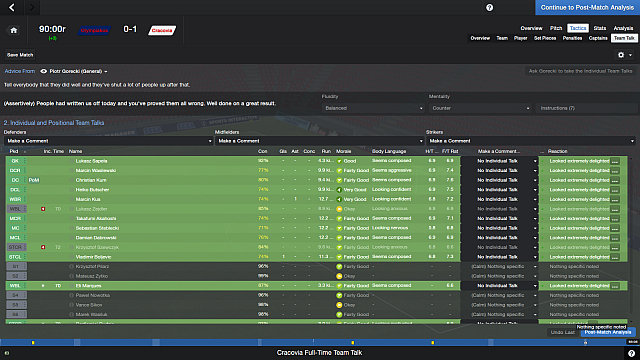 It's a good idea to compliment your players after you win a hard match.
It's a good idea to compliment your players after you win a hard match.Team talks often get too little attention, however you should take a look at them, a good talk may turn the tide of the match. You can talk to your team before the match, during the half-time and after the match. You can talk to the whole team, specific positions or individual players.
Before a match against a weak opponent you can expect a victory, if you've been winning lately, tell your players to keep doing it. If the next game is against an experienced team, you can tell your players not to worry if you're not expecting a victory, they can surprise you and opposition's overconfidence might be to your advantage. In the half-time, depending on the score, either compliment the team or tell them that you're disappointed. The same after the match: you should compliment the players especially after a victory against an experienced team, but when they lose, you mustn't pretend that they played well (unless it was a minor failure and the opposition was very strong, then you can say it was unfair). If the players react negatively, you should talk to them individually. You can also do it by introducing a substitute.
You can see the influence on players in the Reaction column. If they react positively, their names will be underlined in green, if negatively - in red. Your talk can also be ignored, then the name won't be underlined.
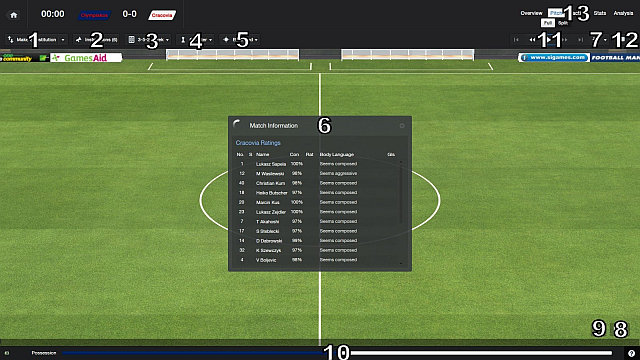
This is the match screen, view of the pitch. Specific elements marked on the screenshot.
1. Make a substitution - you can quickly introduce a new player.
2. Shout instructions - instructions that you can shout from the touchline. These are the same instructions that you can set in Player instructions tab in the tactics menu.
3. Tactic - lets you quickly change a tactic.
4. Mentality - can change team's mentality.
5. Playing style - lets you quickly change playing style.
6. Overview - here you'll see various information, for example player evaluation.
7. Settings - you can change speed, view and shown situations here.
8. Match day options - You can choose several windows to show on the screen, for example player evaluation, formation etc.
9. Maximize - Maximizes the match view.
10. Possession - shows possession and commentary.
11. Start/stop buttons - they let you stop, rewind etc.
12. Match feed - you can see all notifications, messages, your coworkers' advice etc.
13. Overview, Pitch, Tactics, Stats, Analysis - a variety of stats and tables for the match, analysis of individual players and whole team, match stats and much more.
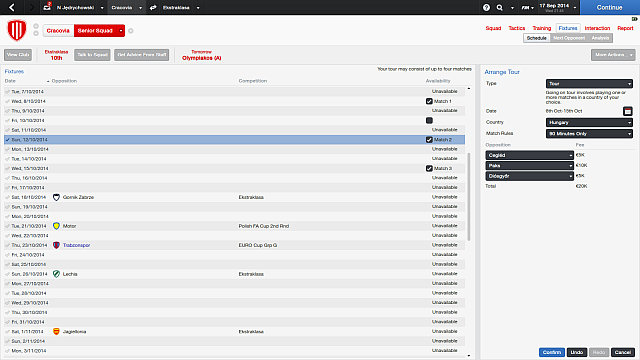
Proper money management is a very important part of managing a team, especially in clubs that don't have multi-million budget. Here's a few ways to earn money.
1. Arranging friendlies
Playing friendly matches between rounds is not only a great way to test your strategy and keep your players fit but also a great way to earn money, especially for smaller clubs. Away matches are the best for this but the board might not agree for very long trips.
2. Cut wages back
Take a look at your reserves and juniors, perhaps somebody earns too much. Or maybe you have a displeased "star" in your first team? Sell them as soon as possible and loan your juniors. You'll get money for transfer and you won't have to pay your juniors who will gain experience.
3. Find a parent club
Finding a parent club is a very good way to get an injection of money every year. To do it go to Boardroom and choose a proper option in contract options. A parent club, aside from giving you money, lets you borrow their players that aren't in their first team without paying them 100% of their wages.
4. Fight for cups
Don't ignore matches with weak opponents and cup competitions, though they often aren't as important as the league for you. Cup victories or just getting as far as possible in competitions will give you quite a lot of money. If you manage to be good in the Champions League, you'll get a really impressive reward so use your best squad for European championships.
5. Get players with no contracts or agents
Searching for players that aren't currently in any club is a great way to improve your team while saving money. You don't have to pay any fee and you can get to contract negotiations. You'll save even more if the player doesn't have an agent. If you count every penny, you can save lots of money.
6. Take a look at your coaching staff
Perhaps your club has too many coaches or physiotherapists. Leave only those who are really needed and responsible for something. The rest isn't useful and you can fire them. See if you need many scouts and physiotherapists because some of them don't do anything and you have to pay them anyway.
7. Be careful extending contracts
Every year, some players' contracts will expire. If you want to extend them, be careful because most players will demand a rise. There's nothing wrong about it but remember not to agree to the initial conditions - always try to negotiate. You'll save a noticeable amount of money.

If you want to have the best players in your team, you have to find them first. You can't find all of them by yourself so you should hire the right people.
1. Hire scouts
One of the ways to hire scouts is to release a job advertisement. After a few days you should get replies. If nobody is interested, use the menu responsible for searching for staff. Things you should consider: knowledge about countries you're interested in and attributes: mainly Judging player ability and Judging player potential. Tactical knowledge will be useful for a scout whose responsibility is to prepare reports on opponents.
2. Setting responsibilities
Check where you can delegate your scouts because the board won't always agree to placing them all around the world. You can check it in the Boardroom.
Then choose responsibilities for individual scouts. It can be the next opponent, a specific country, region or all the continent. Regardless of the selected option, choose the attributes, potential etc. that you're interested in to get reports only on players you'll want.
3. Getting the results
After you hire proper scouts and selecting their responsibilities, you only have to wait for their reports. Pay attention to your inbox and analyze your next opponent regarding the scouts' reports. Remember that you can monitor individual players. To do it, click Scout's report on his profile and after a while you'll get a report about him.
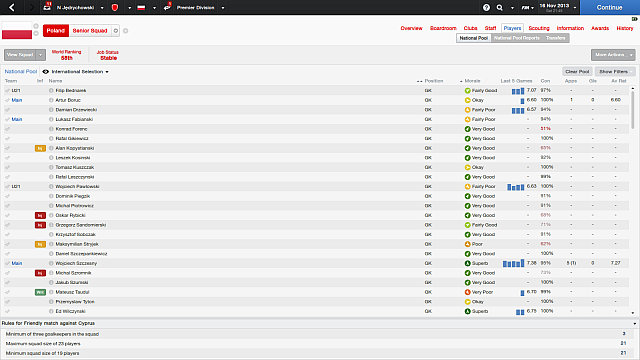
In Football Manager 2014 you can also manage any national team you want. You can either manage both the club and the national team if you want. You can also skip choosing a national team in the beginning, hoping that you'll become one thanks to your reputation as a club manager. You will get offers but mainly from exotic countries - nobody will leave managing English or German national team to an inexperienced manager.
Some advice for a future Roy Hodgson:
1. Check the available players
If you manage a team you know, there won't be a problem because you'll recognize most names. Search through all available players and look for promising ones in junior teams. If you find someone you want, let him play as soon as possible so he can gain experience in international matches. If you get a job in Ghana or Turkey, it will be a bit more difficult because you probably won't know the players. In that case, you'll have to see all profiles, check your players' attributes, strengths and weaknesses, then decide who you want in your team.
2. Choose a proper strategy
Just like in a club, you'll have to choose strategy. You'll have more freedom because there's much more players. Experiment in friendly matches, let your young players gain experience, prepare your team for tournaments.
3. Breaks between matches
If you've chosen to manage only a national team, keep in mind that there can be months between matches. You should monitor your best players, check their fitness and search for new players worth recruiting. It's a good idea to go to some matches that your assistant recommends to see your players do their job. Choose opponents for friendly matches carefully because they can be arranged only on precise dates.
4. Choosing 26 players
After a long period of waiting your players will finally test their abilities. First you have to choose the best players who will get to play in the colours of the national team. You should pay attention to injuries and current fitness of the players. It may turn out that some players that you didn't select six months ago are now really good and are worth giving them a chance.
5. The match day
Match preparations, choosing strategy and the match itself are quite similar to the ones in the league. There will be a conference before the match, coaches and former players' speeches, pep talk and, finally, the match. You should be prepared, know the strengths and weaknesses of both your and opponent's teams and use your strong points to the max. Remember that the matches are quite rare so you can't ignore friendlies, let alone the competitive matches.

Proper coaching staff provides harmony and balance in the team. You should take a look at this tab, fire unnecessary/bad employees (they will agree to a mutual termination) and hire the best professionals.
Members of staff you must have:
1. Assistant manager
Most important attributes: man management, mental, tactical knowledge, working with youngsters, determination.
The second most important person, your assistant. He runs the team while you're away and you can give him a lot of tasks, for example managing the team during friendly matches, team talks and extending contracts. He can also be responsible for training. He's a very important person in the team and you should get the best one even if it costs you a lot.
2.Coach
Most important attributes: tactical, defending, attacking, goalkeepers, working with youngsters, tactical knowledge, determination.
He's responsible for your team's training. His attributes should be high enough. Don't expect every coach to be good at everything - let one be specialized in defence, other in goalkeepers etc. Choosing the right coaches will make your players' skills increase so they'll play better. Better players are more expensive so the cost of coaching staff will pay off.
3. Physio
Most important attributes: physiotherapy, determination.
A physio is responsible for injured players. He should be a professional and heal them as fast as possible. Having a bad physio may have negative influence on your team.
4. Scout
Most important attributes: judging player ability, judging player potential, determination.
He doesn't directly influence the playing but he's an important person who looks for young, promising players. A good scout will judge player's abilities and potential so he won't send you hundreds of reports on players who will turn out to be a mistake. You should have a good scout because you can earn a lot of money by training young players.
5. Director of sport
Most important attributes: man management, working with youngsters, level of discipline, determination.
He assists the manager. You can give him some of your responsibilities, for example: selecting coaching staff, extending contracts, making a list of players for sale etc. It's useful if you can't find clubs interested in buying players that you don't want.
6. Head of youth development
Most important attributes: man management, working with youngsters, determination.
He's responsible for junior team: coordinates their training, extends their contracts, gives you reports on progress in training. Good one will make your youngsters gain experience.
Choosing good coaching staff will provide harmony in the team, development of youngsters, care about injured players and promising transfer targets. You should select the best possible staff to get good results.
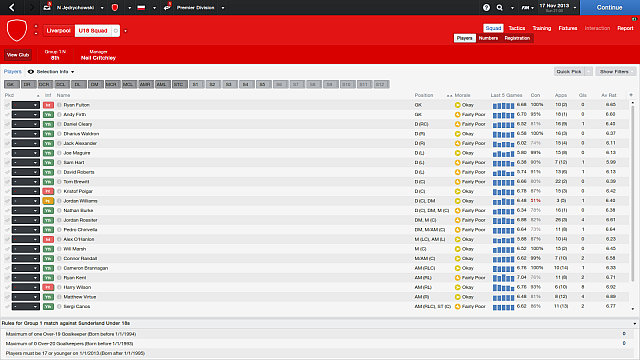 The world is theirs
The world is theirsThe players listed below are young and promising. You should take a look at them right after you start playing because the better they are, the more expensive they become. Some of them, with right training and after a few seasons will have a chance to become world class stars. If you're looking for an investment for a few years, you're in the right place.
These stats are up-to-date only in the beginning, after some time attributes and value change. The game also generates its own players, so it's important to delegate your scouts all over the world.
Values are in euro, wage - weekly.
Name
Team
Age
Value
Wage
Wojciech Pawlowski
Latina
20
250,0 K
1,9 K
Sam Johnstone
Manchester United U-21
20
475,0 K
3,5 K
Jan Oblak
Benfica
20
550,0 K
10,0 K
Nicola Leali
Spezia
20
650,0 K
8,0 K
Mattia Perin
Genoa
20
1,2 M
16,75 K
Timo Horn
Koln
20
2,2 M
13,5 K
Maxym Koval
Dynamo Kyiv
20
2,9 M
5,75 K
Jack Butland
Stoke
20
3,1 M
14,75 K
Name
Team
Age
Value
Wage
Lucas Digne
PSG
19
1,9 M
60,0 K
Wallace
Inter
19
2,5 M
21,5 K
Jetro Willems
PSV
19
3,6 M
9,0 K
Mattia De Scigilio
AC Milan
20
4,3 M
37,5 K
Luke Shaw
Southampton
18
5,0 M
29,5 K
Name
Team
Age
Value
Wage
Elio Capradossi
Roma U-19
17
325,0 K
725,0
Alessio Romagnoli
Roma U-19
18
775,0 K
8,5 K
Kurt Zouma
AS Saint-Etienne
18
3,0 M
12,25 K
Samuel Umtiti
Olympique Lyonnais
19
4,0 M
14,75 K
Matija Nastasic
Manchester City
20
7,25 M
89,0 K
Name
Team
Age
Value
Wage
Sergi Samper
Barcelona U-19
18
275,0 K
65,0
Josip Radosevic
Napoli
19
1,4 M
10,0 K
Junior Malanda
Zulte Waregem
18
1,6 M
4,5 K
Emre Can
Bayer 04 Leverkusen
19
3,0 M
15,0 K
Geoffrey Kondogbia
AS Monaco
20
7,5 M
47,0 K
Name
Team
Age
Value
Wage
Gedion Zelalem
Arsenal U-18
16
170,0 K
90,0
Oliver Torres
Atletico "B"
18
950 K
9,0 K
Leon Goretzka
Schalke
18
3,0 M
15,0 K
Nick Powell
Wigan
19
4,2 M
3,5 K
Paul Pogba
Juventus
20
14,0 M
33,5 K
Name
Team
Age
Value
Wage
Valentino Lazaro
Red Bull Salzburg
17
215,0 K
-
Juan Fernando Quintero
FC Porto
20
3,6 M
6,75 K
Maximilian Meyer
Schalke
17
3,9 M
15,0 K
Mateo Kovacic
Inter
19
4,4 M
51,0 K
Adam Maher
PSV
19
4,4 M
8,75 K
Name
Team
Age
Value
Wage
Julian Brandt
Wolfsburg U-19
17
1,1 M
800,0
Agustin Allione
Velez
18
1,8 M
3,8 K
Memphis Depay
PSV
19
1,9 M
6,0 K
Viktor Fischer
Ajax
19
4,0 M
3,2 K
Gerrard Deulofeu
Everton
19
6,0 M
10,5 K
Name
Team
Age
Value
Wage
Hervin Ongenda
PSG U-19
18
49,0 K
1,2 K
Luke Djordjevic
FC Twente
19
475,0 K
-
Balde Keita
Lazio U-19
18
700,0 K
6,75 K
Jean-Marie Dongou
Barcelona
19
800,0 K
6,5 K
Yassine Benzia
Olympique Lyonnais
18
1,0 M
9,0 K
Arkadiusz Milik
Augsburg
19
1,6 M
8,5 K
Domenico Berrardi
Sassuolo
18
2,9 M
10,0 K
Aleksander Mitrovic
Anderlecht
18
3,0 M
10,75 K
Luciano Vietto
Racing Club
19
3,0 M
4,7 K
Romelu Lukaku
Everton
20
13,5 M
47,5 K
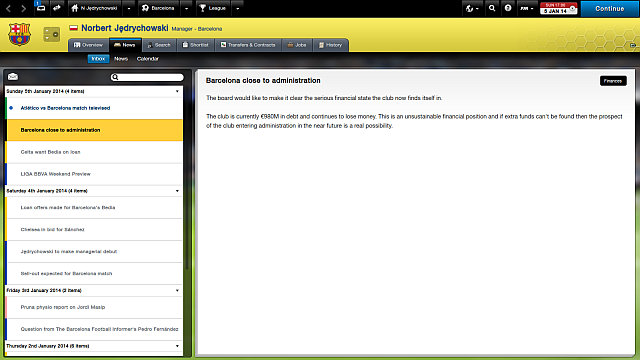 Barcelona on the verge of bankruptcy.
Barcelona on the verge of bankruptcy.All challenges have been played on normal difficulty. The difference between levels of difficulty varies between challenges so losing points, debt or number of injured players increases. In some challenges difficulty also depends on a team you choose. It's easier with a pre-season favorite than a small, weak team.
"Your team are embroiled in a relegation battle halfway through the season. Can you take the reins and guide them to safety?"
Main goal: stay in the league
Your team is several points away from a safe position. You have to go up the table in less than half of the season. Don't bother yourself about the transfers - use your players to the max and if you lack some, take some from the reserves. Correct formation and tactic are crucial. Get all points on your own pitch and try to score at least one point in the away matches, use defensive formation and play with counters.
"Your team is swamped with injury problems, leading to most of your first team players being on the treatment table. Can you meet the board's expectations in the league?"
Main goal: meet the board's expectations
Regardless on the team you choose, the amount of injuries in your team may give you a headache. The hardest thing is that main players of your first team are injured. The goal will vary depending on the team you choose - some have to fight for a trophy and some will just have to stay in the league. To meet the board's expectations you'll have to replace the injured players. To do it, you should look in your reserves for young players with good physical attributes or older but with more experience and better technical abilities. Choosing a strategy for the players in your team will be very important. Use their best skills as much as possible.
"You've gone on a long run without defeat. Can you cement your place in history by going the full season unbeaten?"
Main goal: don't lose any match
You're halfway through the season so you won't play against every team. Check your calendar and be ready for strong opponents. You shouldn't have any problems winning on your own field because the team's morale is very high. Remember that you shouldn't ignore the opponent and go in a fully offensive formation because you'll risk counterattacks. When away, you should either score a goal as soon as possible and move into defence, or play in defence from the beginning. Don't try to finish the match with 0:0 because losing a goal in the final minutes might lead you to a failure.
"A batch of exceptional youth players has risen through the ranks and joined your first team. Can you claim silverware with a side built around this core of young, homegrown talent?"
Main goal: win the trophy; young players must be among 11 players with most appearances in the team
A few interesting juniors join your first team. In the squad view their names are orange. To complete this challenge it's essential to have them in your first team as often as possible. You have all the season to get the trophy, it's important to monitor the young players' exhaustion because you won't win if they're too tired - don't use them in every match. Another thing you should keep in mind is their position among other players (number of appearances). Check if they're high in this rank from time to time.
"Your appointment as manager has left some senior players unhappy. How will you handle the dressing room and the inevitable egos within? Can you avoid being sacked before the end of the season by matching the board's expectations?"
Main goal: meet the board's expectations
The board's expectation depend on a team you choose. Some players (mostly the best ones) will be unhappy with your appointment, it will be marked with a proper icon next to their names. You have half of the season to convince them that you were the right choice. The best way to do it will obviously be winning matches and meeting the board's expectations. Take a look at the reserves, perhaps you'll find a replacement for the unhappy players.
"Your side will be immediately promoted to the top division in their country. How will you fare as massive underdogs?"
Main goal: stay in the league
The team selection will be limited to all leagues except the highest one. The weaker team you choose, the harder it gets. You have to stay in the top league for whole season. It's a good idea to acquire the players you need, preferably from free transfers. Get points at home and against weaker opponents. Choosing a proper strategy for each opponent will make staying in the league possible. A proper tactic suited for each player will result in the fact that supporting this person will become possible.
"Your club is in financial peril. Can you maintain competitiveness on the pitch whilst reducing the club's debt and wage bill off it?"
Main goal: meet the board's expectations; reduce debt
Firstly, you should see how much debt your club has and how much you exceed wage budget. Unfortunately, the main way to reduce debt and wage expenses is selling the players. Selling one or two players with highest wages will be more effective than selling half of your team. Remember not to accept the initial conditions in negotiations. Try to negotiate instantly taking as much money as possible instead of monthly fees. Check the reserves - perhaps you have some players that could replace the ones you've sold. You can also sell some of them, you'll save money. When you get a message about being close to receivership, be careful, you're on the verge of failure.
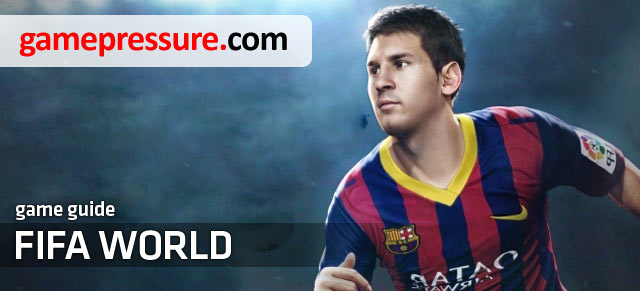
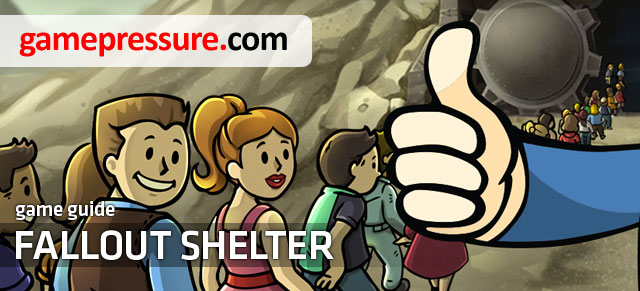


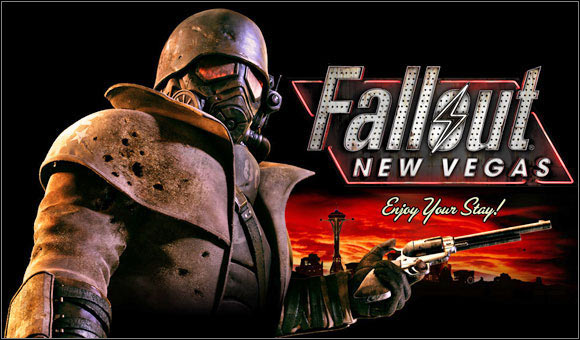 Fallout: New Vegas Game Guide & Walkthrough
Fallout: New Vegas Game Guide & Walkthrough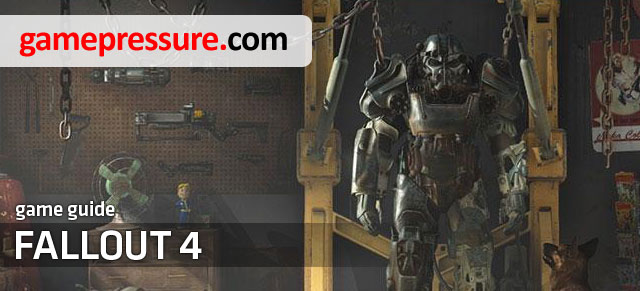 Fallout 4 Game Guide & Walkthrough
Fallout 4 Game Guide & Walkthrough Football Manager 2015 Game Guide & Walkthrough
Football Manager 2015 Game Guide & Walkthrough Flight Simulator X Game Guide & Walkthrough
Flight Simulator X Game Guide & Walkthrough Farming Simulator 2013 Game Guide & Walkthrough
Farming Simulator 2013 Game Guide & Walkthrough